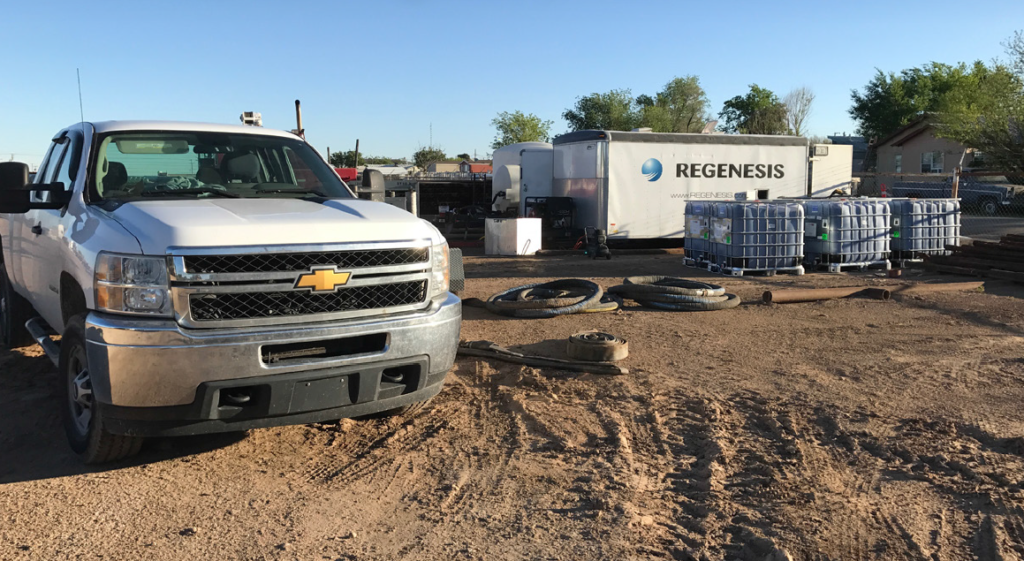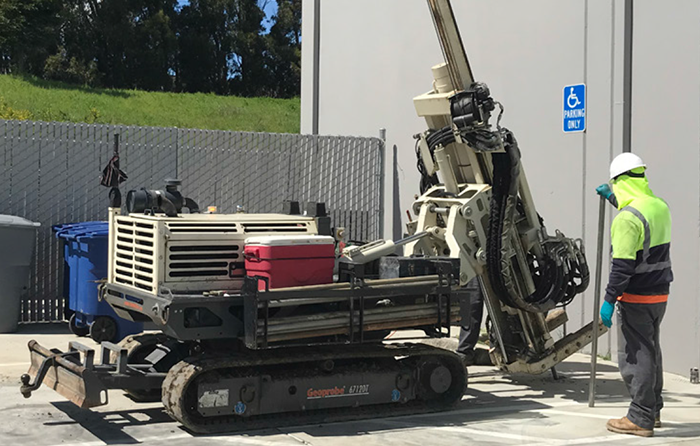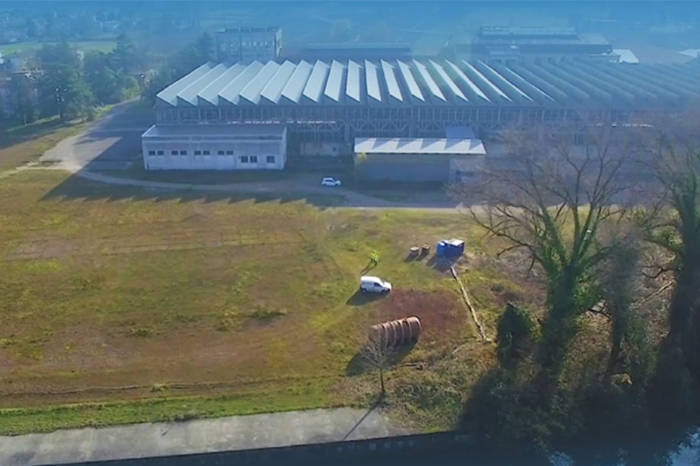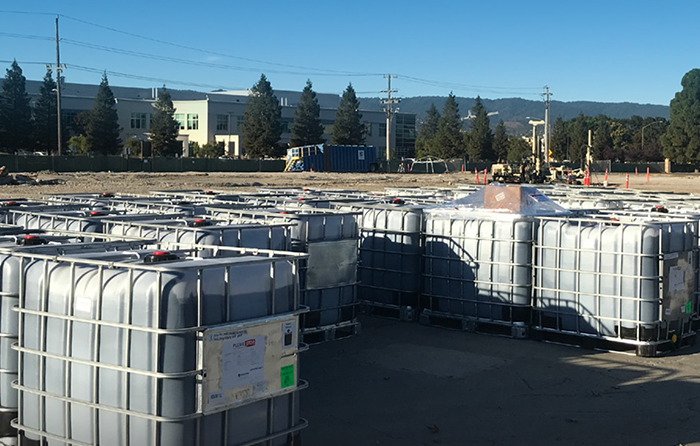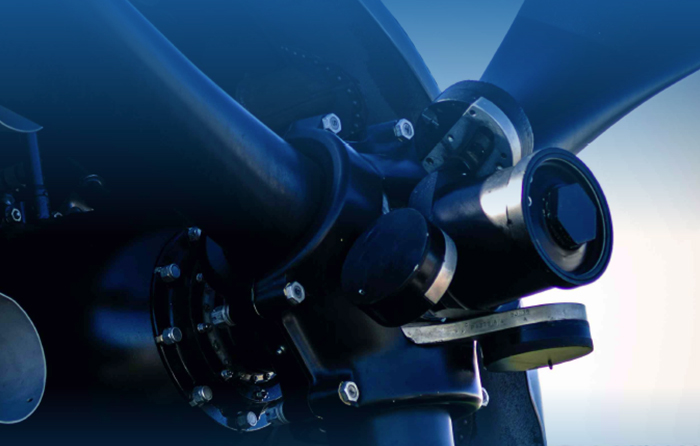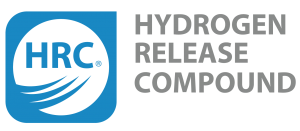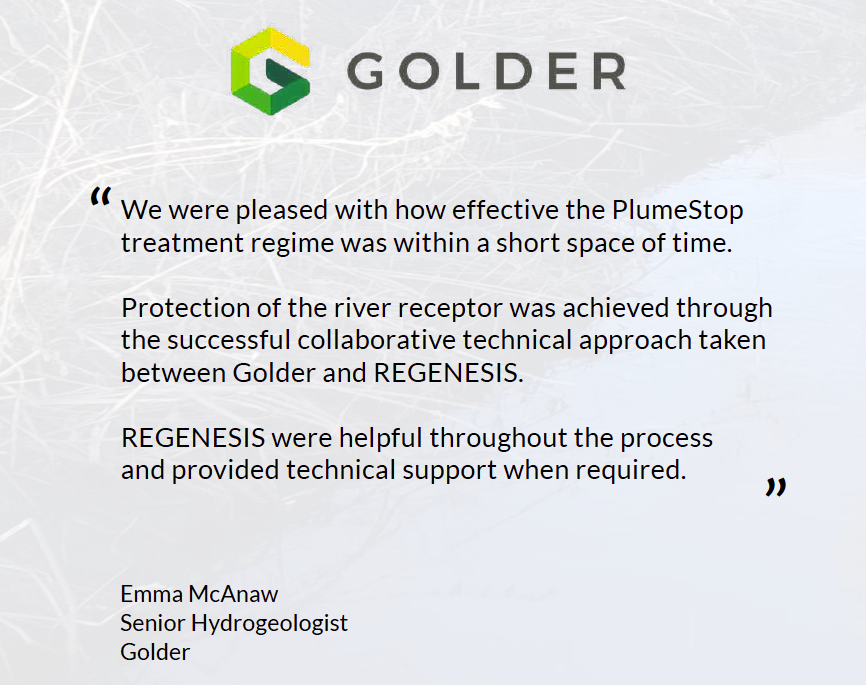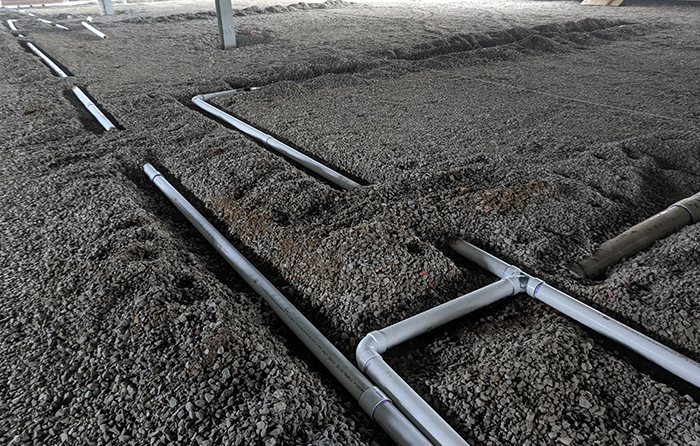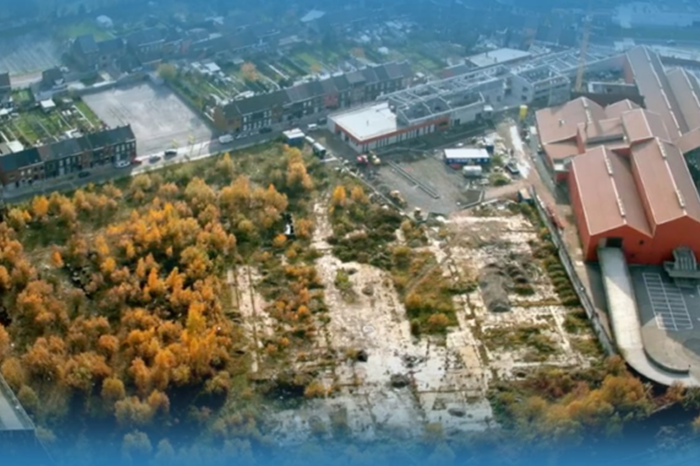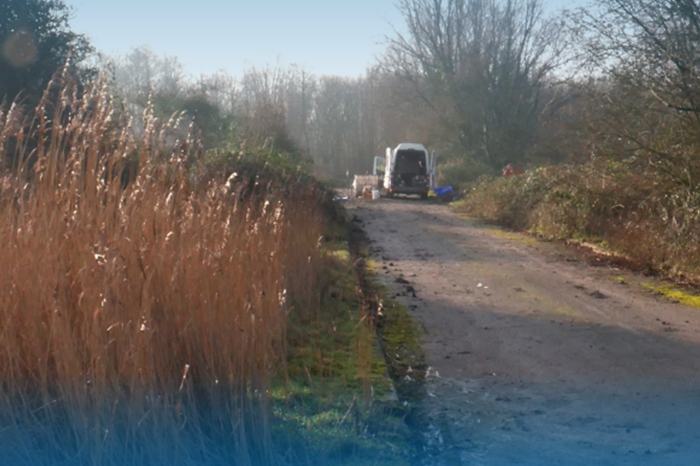PlumeStop Barrier Protects Drinking Water Supply Wells
Case study highlights:
- Innovative remedial approach addresses large PCE plume at a bedrock site under the CERCLA-Regulatory Framework
- Substrates successfully addressed contaminants in the Ogallala Sandstone
- PlumeStop PRB successfully cut off PCE and chlorinated solvent daughter products and prevented further movement downgradient toward private water supply wells
This case study reviews a former chemical manufacturing facility in Texas where PlumeStop® Colloidal Activated Carbon was used in a permeable reactive barrier (PRB) to halt the movement of chlorinated solvents in groundwater. EA Engineering, Science, and Technology, Inc., PBC, a leading multi-disciplinary environmental and engineering consulting firm, contracted REGENESIS to implement the solution. PlumeStop was to be applied as part of an in situ bioremediation PRB near the distal end of the plume to promote sorption-enhanced natural attenuation of the contaminants.
PCE Concentrations Greatly Reduced within 30 Days
Case study highlights:
- High PCE concentrations were detected in soil and groundwater during a site investigation
- A pragmatic, phased approach was used to target PCE in soil and groundwater
- The multi-component treatment was immediately effective and has maintained 98% PCE reduction in onsite groundwater
The site is a former dry-cleaning supply distribution business that operated from 1957 to 2000. The former facility provided laundry chemicals, including detergents and spotting chemicals, packaging products such as hangers and polyethylene bags, and bulk deliveries of tetrachloroethene (PCE). Remediation at the site was completed in two primary phases. The first phase was a targeted excavation and soil mixing event focused on addressing the highly impacted shallow soils and smear zone. The second phase was focused on treating the groundwater PCE plume onsite and preventing further plume migration offsite.
DNAPL to Non-Detect: 6 Orders of Magnitude Reduction of Chlorinated Solvents
Case study highlights:
- Extensive chlorinated solvent contamination on a complex site was remediated using in situ treatment, including Enhanced Reductive Dechlorination (ERD) and a PlumeStop injectable Permeable Reactive Barrier (i-PRB).
- High-contamination areas saw significant reductions in chlorinated solvents, including potential Dense Non Aqueous Phase Liquid (DNAPL).
- A combination of sorption and ERD technologies achieved and maintained very low contaminant concentrations, meeting strict regulatory requirements and allowing for site closure.
Combined in situ sorption and biological degradation leads to site closure of large manufacturing site in Northern Italy. Chlorinated solvents were used for many years at a former manufacturing facility in Northern Italy. This resulted in contamination of the groundwater underlying a large proportion of this 60,000 m2 site. Groundwater concentrations of up to 155,000 μg/L TCE meant there was a suspected presence of Dense Non Aqueous Phase Liquid (DNAPL) on parts of the site. The contamination posed an unacceptable risk to both on- and off-site receptors and it was determined that active remediation was required on a large proportion of the site.
PlumeStop Application Paves The Way For Redevelopment
Case study highlights:
- Design Verification Testing (DVT) from REGENESIS contributes to achieving remediation goals
- Flux-based predictive modeling used to optimize remediation to meet two-year timeline
- Highly successful remediation solution using colloidal technologies paves the way for property redevelopment
This case study reviews a contaminated chlorinated solvent site in northern California where advanced design verification testing and predictive modeling methods were used to guide a remarkably successful in-situ remediation effort. Complete reduction of chlorinated volatile organic compounds (CVOCs) in the treatment areas and remedial objectives achieved allowed redevelopment of the property. The primary CVOC chemicals of concern were tetrachloroethene (PCE) and degradation products, trichloroethene (TCE), cis-1,2-dichloroethene (cis-DCE), and vinyl chloride (VC). PES Environmental, Inc. (PES) of Novato, California, was selected by the developer as their Environmental Consultant for this project. When PES engaged REGENESIS on this project, a better understanding of contaminant flux was needed. By understanding the contaminant flux, a cost-effective remediation plan could be designed, specifically engineered to achieve a project goal. In this case, the goal was to fully remediate the CVOCs in the target treatment areas within two years following application of the treatment approach.
Combined ISCR and in situ sorption of a PCE plume on school grounds in Northern Italy
Case study highlights:
- Safe and easy co-injection of PlumeStop and S-MicroZVI
- 50m long in situ barrier was applied with minimal interference with the school activities
- Significant and rapid decrease of PCE concentrations in all 3 monitoring wells immediately downgradient
An ongoing manufacturing facility located within a major Italian city created a widespread tetrachloroethene (PCE) contaminant plume in the underlying aquifer. The highly aerobic aquifer has inhibited natural attenuation, with no daughter products detected even after many years. Environmental company TAUW is in charge of this site and has implemented hydraulic containment within the factory grounds, as required by law. However, there remained a need to target the plume beyond the site boundary, for which they outlined an in situ solution in collaboration with Prof. Marco Petrangeli Papini from Università La Sapienza di Roma.
Over 8 Million Cubic Feet of Groundwater Treated In 13 Days
Case study highlights:
- 8 million cubic feet of CVOC impacted groundwater treated
- 88,000 gallons of ERD remedial amendments applied in less than 13 days using novel, innovative tooling and application approach
- The project was completed more than 40% faster than originally scheduled.
This case study reviews the site of a large-scale enhanced reductive dechlorination (ERD) treatment of chlorinated volatile organic compounds (CVOCs) applied in a fractured bedrock aquifer at a voluntary remediation site in Pennsylvania. REGENESIS Remediation Services (RRS) began the application in May 2020 and completed it in less than 13 days, averaging nearly 7,000 gallons of fluid volume injected per day at this active facility. In total, more than 260,000 combined pounds of 3-D Microemulsion, Chemical Reducing Solution (CRS) and Bio-Dechlor INOCULUM Plus (BDI Plus) were injected for ERD treatment of the CVOCs. The extensive injection well network and large injection volume required RRS to develop an innovative injection process and containment design. Two 21,000-gallon frac tanks were delivered to the site to hold deoxygenated water used for mixing and to chase product injections. Mixing for the main high-flow system was performed in two large polyethylene tanks that were constantly recirculated to ensure a homogenous mixture.
PlumeStop Treatment of Chlorinated Solvents in a Bedrock
Successful pilot study uses colloidal activated carbon to protect
nearby surface waters, United Kingdom
Introduction
REGENESIS was asked to provide a remediation solution for a Trichloroethylene (TCE) plume in the UK. We worked closely with Golder to design and implement a novel solution that combined Plumestop, HRC and BDI+ to sorb and biologically degrade the contamination, rapidly and effectively reducing contamination downstream to nondetectable
levels.
Case Study Highlights
This pilot study shows that treatment of chlorinated solvent plumes is possible using PlumeStop even with challenging conditions such as a: co-mingled plume, fractured bedrock setting, and a highly variable hydraulic conductivity.
The PlumeStop in situ permeable reactive barrier rapidly reduced downgradient contaminant concentrations and maintained these through a combination of sorption and biological degradation,protecting the adjacent surface water receptor.
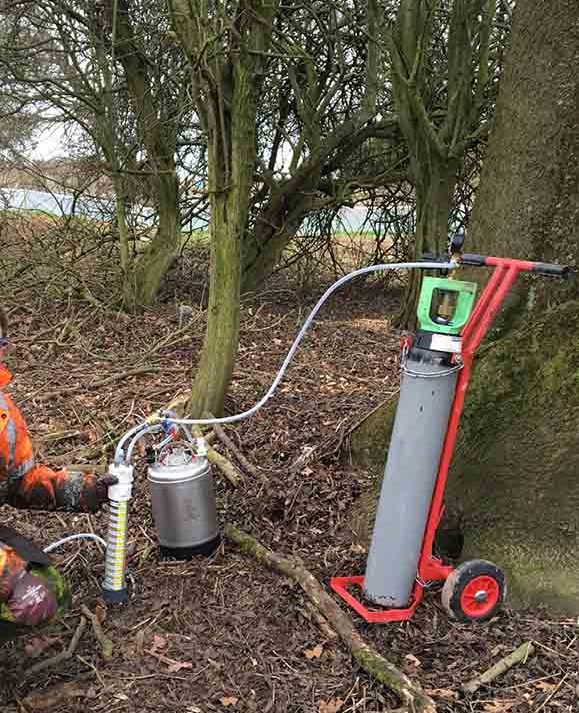
TerraShield Protects Future Occupants from Harmful Vapor Intrusion
Case study highlights:
- TerraShield was considered the safest and most effective choice to protect against the high levels of vapor contaminants found onsite
- The installation of TerraShield eliminated potential health risks for future onsite employees posed by the hazardous vapor intrusion exposure from the TCE and PAH contaminants
- TerraVent, a low-profile trenchless vapor collection system, was installed on this site
A large automotive and supply company planned to build its new corporate headquarters on a 4.5-acre brownfield site recently acquired in Southfield, MI. Soil and groundwater sampling on the property revealed the presence of trichloroethylene (TCE) and polynuclear aromatic hydrocarbons (PAHs). TCE was also identified in soil gas beneath the site. Within the footprint of the planned building itself, contaminant concentrations were found to be in excess of applicable indoor air quality screening levels. The developer utilized brownfield funding from the local authority to conduct the necessary environmental remediation measures.
Remediation of chlorinated solvents under a commercial development, Belgium
Case study highlights:
- How a single application of 3DME resulted in the full reductive dechlorination of a large plume of chlorinated solvents
- How this simple and inexpensive treatment allowed the redevelopment of a highly impacted brownfield site, while allowing construction and economic use to go ahead unimpeded by the remediation occurred beneath the ground
In Belgium, the former Ubell metal-working factory, which had stood abandoned since the 1990’s, was chosen by Spaque to be redevelopment for commercial use. Significant amounts of chlorinated solvents had been observed in the groundwater, both widespread and with high concentrations in the source area. Reductive dichlorination was seen to be occurring naturally, but was stalling at cis-1,2 DCE due to a carbon-limited system. REGENESIS designed a remediation approach that would use a slow-release electron donor to enhance and maintain full and effective reductive dechlorination (Enhanced Reductive Dechlorination (ERD)) of the target contamination.
In situ treatment of MNT, DNT and TNT at former explosives factory
In Situ reagent barriers (HRC) treat contaminated groundwater in sandstone under a schoolRead More

 Americas
Americas Europe
Europe Français
Français Deutsch
Deutsch Italiano
Italiano Español
Español